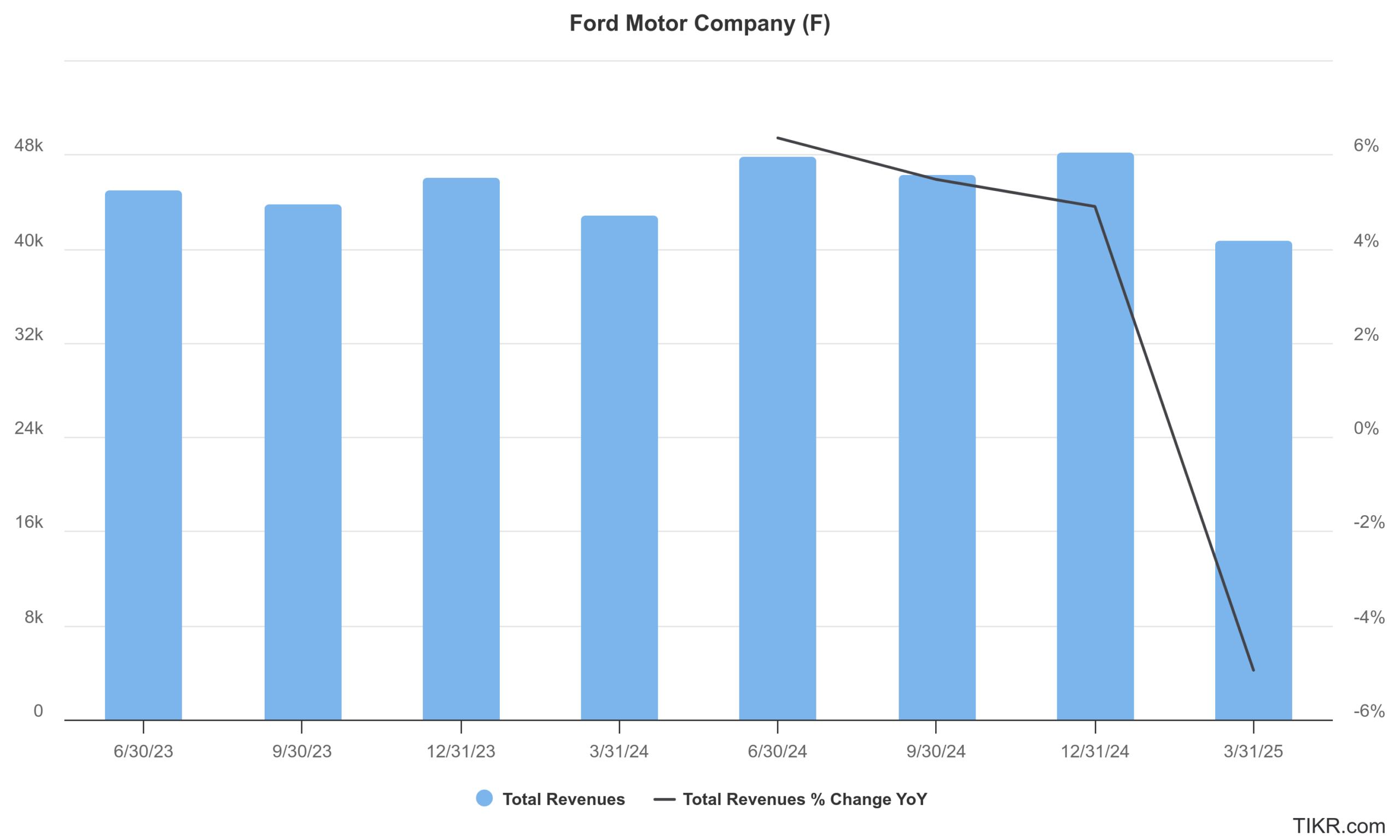Ford Stock Falls After Company Suspends 2025 Guidance Amid Tariff Uncertainty
Please note that we are not authorised to provide any investment advice. The content on this page is for information purposes only.
Ford stock (NYSE: F) is trading lower today after the company suspended its 2025 guidance amid the tariff uncertainty. While it posted better-than-expected numbers for Q1, Ford warned of a $1.5 billion hit from the tariffs.
Ford’s total revenues fell 5% YoY to $40.7 billion in Q1. The company’s automotive revenues came in at $37.42 which was ahead of the $36.21 billion that analysts were expecting. The company generated a net income of $0.5 billion, and its EPS of 14 cents easily surpassed the 2 cents that analysts were expecting.
Table of Contents
Ford Reported Better-Than-Expected Earnings
Looking at the different business segments, Ford Blue which houses the company’s internal combustion engine (ICE) business generated revenues of $21 billion which was 3% lower than the corresponding quarter last year. The segment’s pre-tax profits however nosedived to a mere $96 million as compared to $901 million in the corresponding quarter in 2024.
During the earnings call, CFO Sherry House said, “Ford Blue earned a modest profit, reflecting the expected volume decline in adverse exchange due to the strengthening of the U.S. dollar that impacted key markets like Canada and Australia, offset partially by higher net pricing in North America.”
Ford Pro, which is the company’s commercial business, reported revenues of $15.2 billion – a YoY fall of 15%. The segment posted a pre-tax profit of $1.3 billion which was less that half of what it achieved in Q1 2024.
“Ford Pro showed its resilience by delivering a solid quarter despite the planned downtime at Kentucky truck plant and a normalization in industry pricing in more commoditized areas like delivery vans and daily rental,” said House during the earnings call.
Ford Reported Lower Loss in Its EV Business
Meanwhile, Ford’s Model e business, which is its electric vehicle (EV) business, posted a loss of $849 million compared to $1.33 billion in the corresponding quarter last year. Notably, both Ford and General Motors are struggling with profitability in their EV business, in part due to the price war, which has depressed the pricing.
The price war has also taken a toll on Tesla’s once industry-leading margins, and if not for the regulatory credits, the Elon Musk-run company would have posted a net loss in Q1 2025.
Ford Withdraws Its 2025 Guidance
Ford withdrew its 2025 guidance amid the uncertainty over tariffs. Meanwhile, Ford said that if not for the tariffs, it was on track to meet its 2025 guidance of adjusted pre-tax earnings between $7 billion-$8.5 billion. During the earnings call, House said, “Our results in the first quarter show that the Ford+ [turnaround] plan is working.” She added, “We are transforming this company into a higher growth, higher margin, more capital efficient and more durable business.”
To be sure, Ford is not the only company that’s held back its guidance and several other companies are also choosing to do so given the uncertainty over the tariffs. Economists have raised their odds of a US recession in 2025 amid the tariff chaos.
Tariffs Are A Headwind for the US Automotive Industry
The automotive industry in North America is quite integrated and the tariffs are disruptive for US auto majors. Notably, Canada, Mexico, and the US were covered under the NAFTA (North America Free Trade Agreement) which Trump renegotiated in his first tenure. In July 2020, the USMCA (United States-Mexico-Canada Agreement) replaced the NAFTA which had come into effect in 1994. The USMCA is also scheduled for a review in July 2026.
For years, the US automotive industry benefited from lower production costs in Mexico, and global auto giants set up plants in that country. The tariffs are, however, set to negatively impact companies like Ford, General Motors, and Volkswagen as they all have manufacturing footprints in Mexico and Canada.
General Motors, meanwhile, is more exposed to the tariffs than Ford, as apart from importing parts and vehicles from Mexico and Canada, it also imports finished cars from South Korea and China into the US.
GM Cut Its Guidance Due to the Impact of Tariffs
Incidentally, GM also held back its 2025 guidance during the Q1 earnings release. However, it later warned of a hit of between $4 billion-$5 billion from the tariffs and lowered its adjusted pre-tax earnings guidance to between $10 billion and $12.5 billion, versus the previous guidance of between $13.7 billion and $15.7 billion.
Similarly, it cut the adjusted automotive free cash flow to between $7.5 billion and $10 billion, compared to the previous guidance of between $11 billion and $13 billion.
During the earnings call, CEO Mary Marra said, GM has increased its direct purchases in the US for North American production by 27% since 2019, and over 80% content in its US assembled vehicles are USMCA compliant.
According to Barra, “As tariff policy came into focus, we increased full-size pickup production at our Fort Wayne truck plant, which was already running 3 shifts by approximately 50,000 units on an annualized basis, and we are developing plans to further increase U.S. vehicle production.”
She added, “GM teams are also working directly with our suppliers to further increase their U.S. content and drive even higher levels of USMCA compliance.” GM is also increasing the production of battery modules in the US, which Barra said is “a low-cost way to increase U.S. content.”
How Analysts Reacted to F’s Q1 Earnings?
In their note, BofA Securities analysts said, “Ford delivered a solid performance in 1Q:25, and the lower losses in Model e were encouraging.” The brokerage maintained its buy rating and $14 target price on Ford and added, “Overall, while the estimated impact from tariffs is not insignificant, we think it is relatively manageable in the greater scheme of things.”






